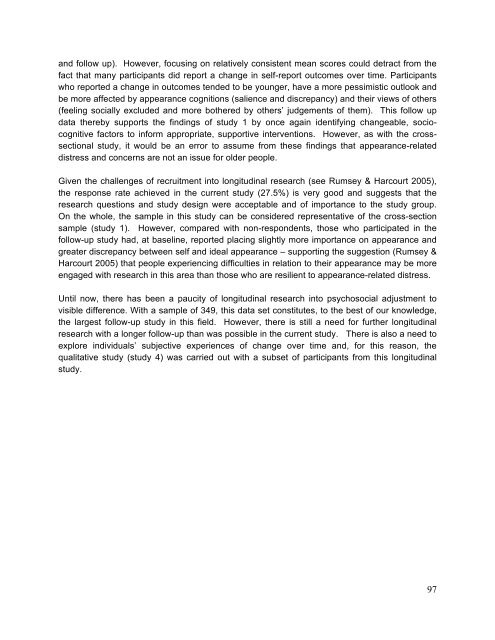Download the report - The Healing Foundation
Download the report - The Healing Foundation
Download the report - The Healing Foundation
Create successful ePaper yourself
Turn your PDF publications into a flip-book with our unique Google optimized e-Paper software.
and follow up). However, focusing on relatively consistent mean scores could detract from <strong>the</strong><br />
fact that many participants did <strong>report</strong> a change in self-<strong>report</strong> outcomes over time. Participants<br />
who <strong>report</strong>ed a change in outcomes tended to be younger, have a more pessimistic outlook and<br />
be more affected by appearance cognitions (salience and discrepancy) and <strong>the</strong>ir views of o<strong>the</strong>rs<br />
(feeling socially excluded and more bo<strong>the</strong>red by o<strong>the</strong>rs’ judgements of <strong>the</strong>m). This follow up<br />
data <strong>the</strong>reby supports <strong>the</strong> findings of study 1 by once again identifying changeable, sociocognitive<br />
factors to inform appropriate, supportive interventions. However, as with <strong>the</strong> crosssectional<br />
study, it would be an error to assume from <strong>the</strong>se findings that appearance-related<br />
distress and concerns are not an issue for older people.<br />
Given <strong>the</strong> challenges of recruitment into longitudinal research (see Rumsey & Harcourt 2005),<br />
<strong>the</strong> response rate achieved in <strong>the</strong> current study (27.5%) is very good and suggests that <strong>the</strong><br />
research questions and study design were acceptable and of importance to <strong>the</strong> study group.<br />
On <strong>the</strong> whole, <strong>the</strong> sample in this study can be considered representative of <strong>the</strong> cross-section<br />
sample (study 1). However, compared with non-respondents, those who participated in <strong>the</strong><br />
follow-up study had, at baseline, <strong>report</strong>ed placing slightly more importance on appearance and<br />
greater discrepancy between self and ideal appearance – supporting <strong>the</strong> suggestion (Rumsey &<br />
Harcourt 2005) that people experiencing difficulties in relation to <strong>the</strong>ir appearance may be more<br />
engaged with research in this area than those who are resilient to appearance-related distress.<br />
Until now, <strong>the</strong>re has been a paucity of longitudinal research into psychosocial adjustment to<br />
visible difference. With a sample of 349, this data set constitutes, to <strong>the</strong> best of our knowledge,<br />
<strong>the</strong> largest follow-up study in this field. However, <strong>the</strong>re is still a need for fur<strong>the</strong>r longitudinal<br />
research with a longer follow-up than was possible in <strong>the</strong> current study. <strong>The</strong>re is also a need to<br />
explore individuals’ subjective experiences of change over time and, for this reason, <strong>the</strong><br />
qualitative study (study 4) was carried out with a subset of participants from this longitudinal<br />
study.<br />
97


